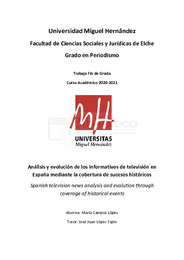Por favor, use este identificador para citar o enlazar este ítem:
https://hdl.handle.net/11000/25790Registro completo de metadatos
| Campo DC | Valor | Lengua/Idioma |
|---|---|---|
| dc.contributor.advisor | López Espín, José Juan | - |
| dc.contributor.author | Campos López, María | - |
| dc.contributor.other | Departamentos de la UMH::Estadística, Matemáticas e Informática | es_ES |
| dc.date.accessioned | 2022-01-31T07:53:55Z | - |
| dc.date.available | 2022-01-31T07:53:55Z | - |
| dc.date.created | 2020-11-27 | - |
| dc.identifier.uri | http://hdl.handle.net/11000/25790 | - |
| dc.description.abstract | Los informativos de televisión son uno de los recursos audiovisuales a los que la población española más accede para obtener datos sobre las noticias más importantes. En marzo de 2020, 41 millones de espectadores vieron los informativos de diversas cadenas españolas. Según un estudio, durante el confinamiento dado por la crisis de la pandemia de la Covid-19, cada español consumió alrededor de cinco horas diarias de televisión. 33 millones y medio de españoles se congregaron diariamente frente a las pequeñas pantallas para conocer los últimos datos. Un 74% de ciudadanos sigue eligiendo las televisiones para entretenerse, pero también para informarse. (Barlovento Comunicación, 2020) Sin embargo, los informativos de televisión están pasando por una época convulsa y les augura un futuro cuanto menos incierto. El periodismo ciudadano, la pérdida de credibilidad y su consecuente aumento debido a las fake news, la llegada de innovadoras y más rápidas vías de comunicación o la falta de interés por parte de la audiencia más joven son algunos de los frentes a los que este formato debe combatir. Todos ellos, se abordan en este proyecto que pretende indagar en la historia de los noticiarios televisivos para entender cómo se ha forjado uno de los formatos más atractivos para las audiencias. Pero, para llegar más allá y entender mejor este medio, no solo hay que analizar su historia sino comprobar cómo esos pasos que se han ido dando se han incorporado. Para ello, analizaremos la cobertura mediática de ocho sucesos históricos por parte de los telediarios más vistos en nuestro país. La llegada del hombre a la luna, el accidente nuclear de Chernóbil, la caída del muro de Berlín, el ataque terrorista del 11- S, la guerra de Iraq, el atentado terrorista del 11- M, el terremoto de Haití y la pandemia mundial de la Covid-19; ¿Cómo lo contaron las televisiones españolas?, ¿Cómo lo trasladaron a la ciudadanía? En este proyecto se analiza no solo la historia de los informativos, sino los errores de una mala práctica periodística, informaciones no contrastadas, informaciones con intereses, desinformación o sobreinformación son solo algunas de ellas. | es_ES |
| dc.description.abstract | The televisión news are one of the most mass media watched by Spanish public in order to get information about the most important piece of news. In march 2020, 41 million spectators watched the televisión news from the different spanish chanels. According to the data, during the Covid-19 confinement, each spaniard consumed around five hours of television everyday. 33 millions and a half spanish people sat down in front of tv to know the new updated data. This means that 74% citizenship still chose television, not only for entertaiment, but also for information. However, the tv news are facing difficult moments and an uncertain future. Citizen journalism, the lost of credibility and its increase due to fake news, the arrival of innovative and faster communication mass media or the lack of interest from the joungest audience are only one of the front this format must face. A lot of them are dealt with in this project. This project expects to know the history of the televisión news in order to understand how one of the most attractive mass media has been forged. To go further and understand this media better, it is important not only to analyze its history but only the steps given. For this, we will analize the mass coverage of eight historical events by part of the most watched televisión news in our country. The arrival of the man to the moon, the nuclear accident of Chernobyl, the fall of the Berlin wall, the 11-S terrorist atack, Irak war, the 11-M terrorist atack, Haití earthquake and the Covid-19 international pandemic. How did the spanish televisión tell so? How was the citizenship told? In this project we analized not only the tv news history but also the mistakes of a bad journalistic praxys. Not matched informations, interested informations, lack of information or excesive information are just some of them. | es_ES |
| dc.format | application/pdf | es_ES |
| dc.format.extent | 68 | es_ES |
| dc.language.iso | spa | es_ES |
| dc.publisher | Universidad Miguel Hernández de Elche | es_ES |
| dc.rights | info:eu-repo/semantics/openAccess | es_ES |
| dc.rights.uri | http://creativecommons.org/licenses/by-nc-nd/4.0/ | * |
| dc.subject | Informativos de televisión | es_ES |
| dc.subject | Periodismo ciudadano | es_ES |
| dc.subject | Audiencia | es_ES |
| dc.subject | Fake news | es_ES |
| dc.subject | Desinformación | es_ES |
| dc.subject | Television news | es_ES |
| dc.subject | Citizen journalism | es_ES |
| dc.subject | Audience | es_ES |
| dc.subject | Disinformation | es_ES |
| dc.subject.other | CDU::0 - Generalidades.::070 - Periódicos. Prensa. Periodismo. Ciencias de la información | es_ES |
| dc.title | Análisis y evolución de los informativos de televisión en España mediante la cobertura de sucesos históricos | es_ES |
| dc.title.alternative | Spanish television news analysis and evolution through coverage of historical events | es_ES |
| dc.type | info:eu-repo/semantics/bachelorThesis | es_ES |

Ver/Abrir:
TFG-Campos López, María.pdf
1,71 MB
Adobe PDF
Compartir:
 La licencia se describe como: Atribución-NonComercial-NoDerivada 4.0 Internacional.
La licencia se describe como: Atribución-NonComercial-NoDerivada 4.0 Internacional.
.png)